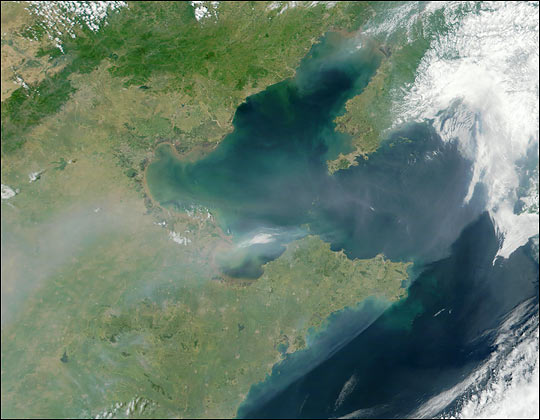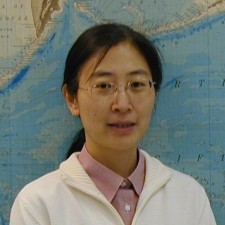Featured Stories, MIT | January 11, 2013
The Global Warming Conundrum: Greenhouse Gases vs. Aerosols
By Genevieve Wanucha
There’s a tricky chemical trade-off at work in our skies. As greenhouse gases provide their famous warming effect to Earth’s surface, aerosol pollution in the atmosphere actually partly counteracts it. Aerosols are tiny particles suspended in the air, both natural and industrial, including sea-salt, mineral dust, ash, soot, sulphates, nitrates, and black carbon. They hang around in the air for around 10 days, scattering and absorbing radiation from the sun. Aerosols also provide nuclei for water droplets, boosting cloud formation, thus decreasing the amount of energy reaching the ground and providing a net cooling force. In short, greenhouse gases warm the surface; aerosols cool the surface.
This trade-off applies to the real world, considering that China and India’s coal burning creates an aerosol problem far worse than the US or Europe ever had before the Clean Air Act in 1970 and the collapse of the Eastern Block’s dirty economy reduced aerosol emissions dramatically. In principle, if China and India were to begin fixing their aerosol problem, which kills hundreds of thousands every year, they might actually contribute to global warming (if they don’t also cut greenhouse gas emissions); the cooling effect of aerosols would be removed, leaving greenhouse gases to warm the globe unimpeded.

This “Faustian bargain,” as NASA climate scientist James Hansen terms it, is a big problem for climate scientists and policy makers. Predicting how the trade-off will affect both global mean and local temperatures is one of the tasks of the century, as made clear in research by a multinational team of researchers, including John Marshall at MIT, published this week in the early online release of Journal of Atmospheric Sciences.
“It’s about quantification,” says Marshall, oceanographer at MIT. “One of the biggest challenges of climate science is to quantify the relative role of aerosols and oceans in cooling the planet’s surface vs. the greenhouse gases warming it. Just knowing the trade-off happens isn’t enough to make useful predictions and inform policy makers.”
Rong Zhang (PhD ’01, MIT), lead author and oceanographer in the Geophysical Fluid Dynamics Lab at NOAA, became curious about a climate model used by a UK research group at the Met Office Hadley Centre to argue in the journal Nature that anthropogenic aerosols are a prime driver of twentieth-century North Atlantic climate variability, even influencing peaks in hurricane activity and the Sahel drought. Zhang and her colleagues decided to look deeper.
They found that the simulations of the “HadGEM2-ES” climate model could not replicate the actual observations of the North Atlantic in the 20th century. Substantial warming trends in the heat content of the upper ocean have been observed in most ocean basins since 1955. Yet, the UK group’s model ocean is much colder. The team discovered that the discrepancy in ocean heat content is influenced and largely caused by modeled aerosol cooling effects on ocean temperature.
Indeed, aerosols, via clouds, reduce energy reaching the ocean, contributing a net cooling effect to both the surface and subsurface ocean temperature. In the model, the aerosol’s cooling effect is so strong it even cancels out any greenhouse gas-induced warming. However, actual observations show a much warmer ocean. “The aerosol effect in their model is overestimated,” says Zhang. She notes that there is probably an issue with how the model handles the exact way in which aerosols affect radiation.
One very difficult problem with modeling the cloud-mediated aerosol effect is cloud formation itself. The small-scale process of cloud formation in Nature is notoriously difficult to model. “The HadGEM2-ES model and most state-of-the-art climate models used for the Fifth Assessment Report of the Intergovernmental Panel on Climate Change only have about 100-km horizontal resolution in the atmosphere,” says Zhang, “which is not enough to resolve the cloud process. The simulation of cloud cover and its effect on radiation using coarse-resolution model grids is one of the leading uncertainties in climate modeling efforts.”
It’s not just the Met Centre that’s having trouble modeling aerosol effects on climate variability. Everyone is. “We simply don’t have sufficient constraints on the history, spatial distribution and microphysics of anthropogenic aerosols,” says Gavin Schmidt, climatologist and climate modeler at the NASA Goddard Institute for Space Studies (GISS) in New York. “Like many seemingly stark dichotomies, the eventual answer is going to be that there is some variability in the ocean circulation and some effect from aerosol and other forcings. But getting an accurate handle on the exact percentage is going to be hard.”
And thus we are left with the knowledge that action to address the greenhouse gas vs. aerosol problem will likely have to proceed without precise quantification of their respective temperature effects. One geoengineering project, currently under consideration, would involve the intentional injection of aerosols, specifically sulphate particles, into the stratosphere (essentially replicating the effect of volcanic eruptions). “If you put aerosols into the stratosphere,” says Marshall,” it will certainly cool the planet’s surface, but there will be other consequences, many unforeseen, for example, to the hydrological cycle and polar caps.” Even if aerosol release worked as intended, continued spewing of carbon dioxide would have worsened other direct consequences of increased levels of the gas, mainly ocean acidification.
Instead of exaggerating the greenhouse gas vs. aerosol balancing act, playing one off against the other, attempting to create such a precise cooling effect by manipulating the most uncertain part of our climate system, we could just cut greenhouse gas emissions. But, you already knew that.







